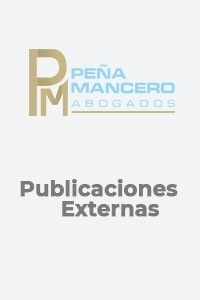Gabriela Mancero and Esteban Rubio
* Originally published in the Bulletin Product and Advertising Law, the International Bar Association, August 2008.
The Federal Trade Commission of the United States (or FTC, for its acronym in English) has been interested in the use of misleading environmental claims in advertising for decades, beginning with the announcement of the biodegradability of detergent in the early seventy.
This concerns regarding advertising and the lack of accurate information to consumers has led to the development of Guides for the Use of Environmental Marketing Claims (Guidelines for the use of statements in relation to the environment in marketing), often called «Green Guides». They were published under Article 5 of the FTC Act in 1992 and revised in 1996 and 1998. In 2008, the FTC has been conducting public workshops as part of a new revision of the guidelines.
These guidelines were created to incline that environmental product claims are true and sufficient information. In fact, the FTC has stated that «in general assertions that ensure benefits for the environment are difficult to interpret, depending on the context, can convey many messages to consumers.»
The guidelines ordered businesses include sufficient information on its comparative statements about the products on the purpose of comparison, the magnitude of the effects on the environment (to avoid overdoing attributes), the need for qualifications, etc. . Therefore, the purpose of these guidelines is to avoid confusing the consumer in some specific advertising.
In Colombia it has not done much to regulate the use of this type of advertising, but there are some legal instruments that consumers and government authorities have at their disposal to control the abuse of such statements.
Worldwide are being carried out related to environmental conservation campaigns because now they are aware of the need for measures to protect the planet.
Global warming, pollution, and all the threats on Earth move consumers to make choices that benefit the environment. Therefore, the «pro-environmental» claims have become very popular as they can influence consumer choice and encourage him to prefer a product that offers these benefits rather than others who do not.
Surprisingly, in Colombia no one has paid attention to this matter, there is no such thing as the Green Guides, or any other instrument that would restrict the use of environmental claims in advertising how do these guidelines, so that consumers may be misled by products that do not meet their expectations.
In Colombia no law or administrative rule now addresses this issue by making it easier for businesses to misuse of the information included on labels and packaging.
Precisely because of the lack of regulation for many companies – particularly large multinationals doing business in Colombia – the use of advertising «green» is important to gain consumer preference tool. The efforts of the FTC have shown that consumer expectations may be affected, since there is insufficient information on the packaging of products to determine the advantages of using them.
As a starting point to control the abuse of green advertising, Colombian law provides a number of tools that can be useful for this purpose:
1. Consumer Protection Statute. Colombia has protected status in this matter which provides for inappropriate actions that may create confusion or change consumer perceptions about a product.
Superintendence of Industry and Commerce (SIC) is the administrative body designated to apply the rules on unfair competition in Colombia, and to carry out the administrative procedures required breached the Consumer Protection Statute. Under Article 14 of the Statute:
«Any information given to consumers about the components and properties of the goods and services offered to the public shall be accurate and sufficient. Are prohibited, therefore, marks, legends and commercial advertising not corresponding to the reality, as well as to induce or deceptive about the nature, origin, method of manufacture, components, applications, volume, weight or measure, prices, how to use, features, properties, quality, suitability or quantity of goods or services. »
This article establishes the obligation to provide consumers with accurate and sufficient information regarding the nature of a product, including its components, characteristics and properties.
The doctrine of the SIC demonstrates how advertising can be misleading. The key element to consider is the image that the consumer actually sees the product, which means how the consumer interprets the information provided. This analysis should be done from the point of view of the average consumer.
The SIC said that only objective information can be evaluated to determine the correspondence between the mental image that the consumer creates any product and the product itself, typifying the use of phrases and messages that overstate the qualities of the product for marketing purposes. This is because the average consumer is aware of the lack of clarity of advertising and exaggeration of the qualities of products that promotes and therefore can understand the difference between reality and exalting them.
2. Decree 2153 of 1992. This regulation granted the SIC ample powers to promote free competition and sanction restrictive trade practices. In accordance with Decree 2153, the SIC may carry out the necessary investigations to determine whether the conduct of a market participant may be considered anticompetitive and apply fines and penalties.
3. Code of self-regulation by advertisers. Although not legally binding, the Code, prepared by the Advertisers Association of Colombia, presents guidelines for those involved in marketing. Establishes the obligation to use accurate information in advertisements and advertising campaigns. It refers to actions considered unethical or unfair towards consumers and prohibits the use of any statement that may cause confusion in them, making claims that are not true or reliable (Art. 15).
4. Environmental Seal. There is one last instrument to control the use of false or inaccurate environmental claims, but has not been fully regulated. The Environmental Seal, created by the Ministry of Environment in 2005, and partially regulated in 2006, is a certificate companies can voluntarily request. It is awarded following an examination of the qualities of a particular service or product available on the market, and its purpose is to demonstrate to consumers that meet environmental requirements.
This seal is one of the first environmental certificates used in Latin America, similar to the German Blue Angel eco-label or European. Its aim is to certify that a particular good or service uses inputs and reusable, recyclable or biodegradable raw materials, employs clean technologies or little harmful procedures to the environment or make sustainable use of natural resources, among others.
As mentioned above, this certificate is not mandatory, but companies can use it as a business strategy or comparative advantage, as it can improve the opinion of the company and its products among its clients. In practice, it can be considered a legal authorization to make green advertising.
The procedure for obtaining the Environmental Label is as follows: the company must submit an application to the ICONTEC (a Colombian private entity associated standards ISO, which promotes and guides the application of Colombian technical standards – NTC) which notifies the application the Ministries of Commerce and Environment. A committee composed of one representative from ICONTEC, a representative of the government, one of the companies and consumer representatives, determines the criteria for granting the Environmental Seal.
The next stage involves the application of these criteria to products or services in question, and the request for a certificate to an independent entity, which must assess whether the company meets the above criteria. If so, the ICONTEC grants the Seal of three (3) year period.
By the time of writing this article, the seal can only be used on a few products, such as household cleaners, oil or gas-powered engines. It can also be applied to services, as well as the hospitality industry. So far, only the «Puerta del Sol» hotel in Barranquilla has received the seal, and more than 10 hotels that have requested is currently awaiting approval.
So far, none of the above environmental standards governing advertising in particular, or in any way limit the use of terms that could be attractive to consumers how do the «green guides», not even seal above average environment, since it only applies to specific products.
The latter is very different, as the evidence and research are conducted by a government agency that is based on criteria agreed by the Ministry of Environment. Thus, this regulation does not apply to all possible environmental claims.
As noted above, our legal system allows us to control the information given to consumers, so that their expectations are satisfied with the product purchased. The SIC, for example, has pointed out how Article 14 of the Consumer Protection Statute should be applied, which requires the use of accurate statements. The law also establishes the competence of this institution to impose sanctions when these rules are violated and also other to protect the interests of consumers.
However, the lack of parameters to determine the scope of information and level of detail should be green advertising, make comparatively more complex than the one with the FTC work, because it has a clear objective and tools to determine when the information provided to consumers is insufficient or incomplete, while the SIC must make a detailed investigation case by case


